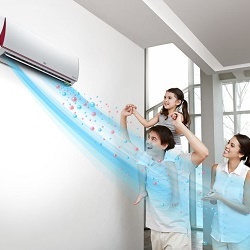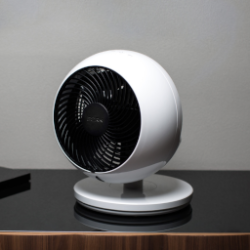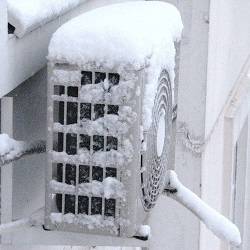Types and types of infrared heaters
Infrared heaters compare favorably with their counterparts completely different principle of heating. If traditional oil or convection the instruments heat the air mass surrounding them, then the infrared units heat the objects to which their rays are directed. What are the types of infrared heaters, and what type is better to choose?
Content
Unusual but true
In exactly the same way, the Sun heats the Earth - by outgoing electromagnetic waves in the infrared range of light, which is indistinguishable to the human eye (for more information about the scheme of action, see the articleprinciple of operation of the heater with infrared radiation).
IR waves have a beneficial effect on the body,one feels pleasant relaxation and comfort, this kind of heat energy is more natural, as it is associated with sunlight.
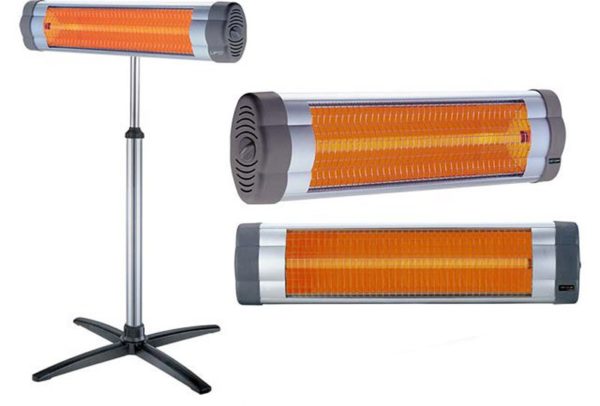
Depending on the power of the radiator, infrared waves are able to penetrate objects and tissues that are heterogeneous in structure to the depth up to 4-5 cm heating them from the inside.
Some users express their concerns about the safety of appliances, comparing the energy they radiate with the high-frequency microwave waves of a microwave oven. However, the tests carried out, as well as practical experience of use, showed the absolute safety and efficiency of IR heaters, and given the advanced automation, even in an emergency, these devices are safer than similar heating systems. The main thing is to follow the rules of installation and use recommended by the manufacturer.
Specifications
Infrared heaters have different technical specifications.. Manufacturers are trying to improve both the emitter itself and additional functions. Additional options include, first of all, active safety systems,such as automatic shutdown in the event of an emergency, overload, the mode of operation in the system of interconnected devices, the possibility connecting the thermostat or smart home systems for remote or fully autonomous control of the device.
Some models boast an elegant design and a slim shape of the front panel, which will perfectly fit into any interior.
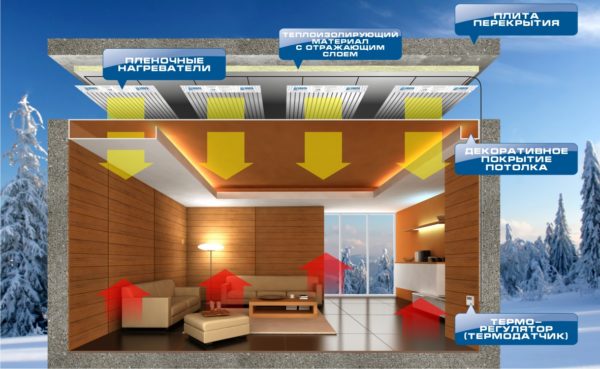
Built-in infrared film heaters
Kinds
Infrared heaters are represented by a fairly extensive product group: from simple electrical models to industrial gas. Consider each group separately.
Electric
Electric IR devices are most often used. at homeThey are quite compact, have a large resource generation and are easy to operate. Depending on the heating element, the following types of electric infacred heaters can be distinguished:
- Ceramic. A non-conductive resist cable enclosed in a ceramic panel that perfectly transmits IR waves is used as a heating element.Ceramic devices, as a rule, are presented in the form of a thin hinged panel with an external thermostat.
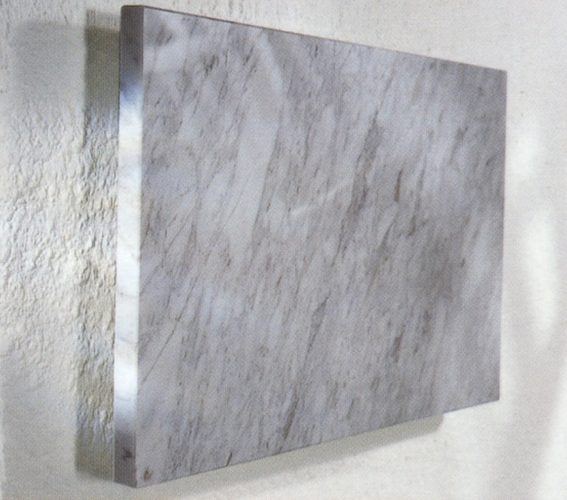
- Carbon fiber. A sealed quartz tube filled with carbon nano-fiber is used as a heater. Such heaters are more economical and also have a healing effect and are often used as a therapeutic device. The price will be much higher than the ceramic panels, but judging by the user reviews, they are worth the money.
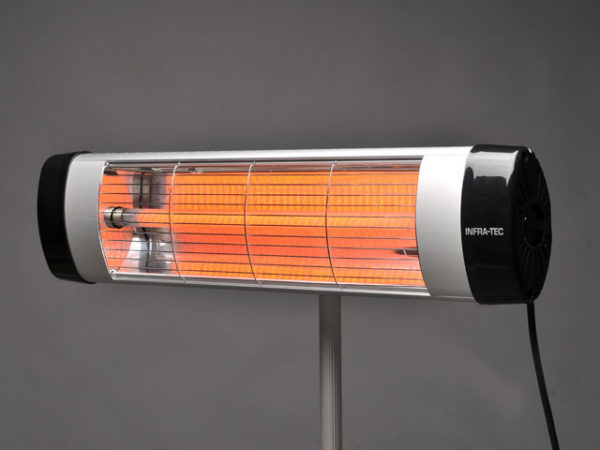
- Film. The heating element here is a flexible resist cable that heats the outer metal film. The film heater can be installed independently - on a previously prepared base. Film models are very flexible, their front surface can heat up to 75 degrees.
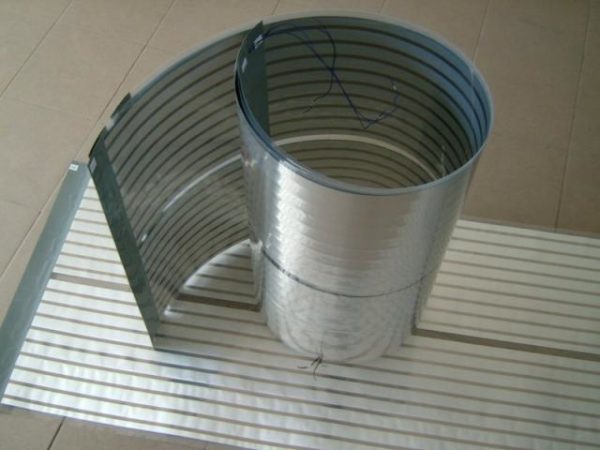
Gas
Gas models work on the same principle as electrical, but as a source of energy is used here gas fuel.
The gas heater is usually installed on the street, in the production hall, or in the stadium at the time of the match.
These devices have much greater thermal power and impressive size,only their height can reach 15-20 meters.
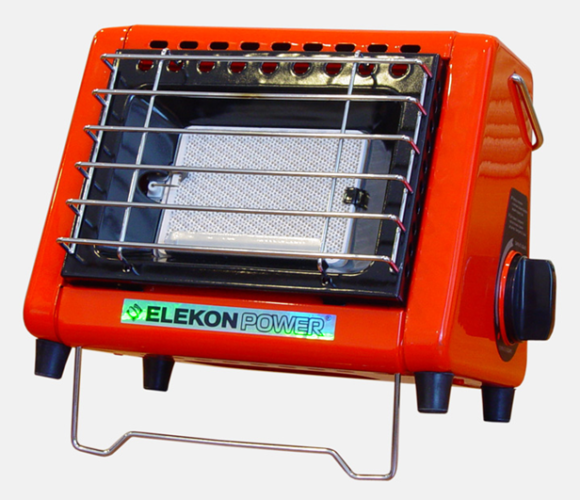
There are more compact models - gas infrared heaters in the form of umbrellaswhich are ideal for outdoor activities on the cold open veranda. Natural gas from various sources - a gas pipe or a portable cylinder with liquefied gas - can be used as a fuel.
Diesel, kerosene and other
You will definitely not see such infrared heaters in an apartment or even in a city; they are used in the construction of large objects and in the technological process of drying wood. The power of such devices is commensurate with gas models, however they more compact and can be reconfigured to work in any conditions.
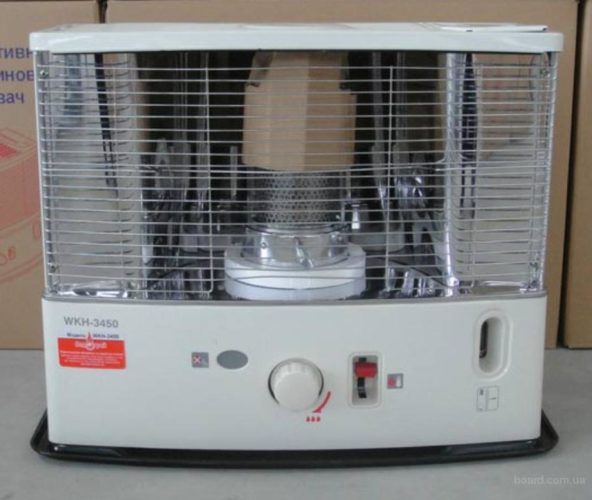
Wavelength classification
Wavelength is a key indicator of an infrared heater, on which the radiation power and the visibility of light by the human eye depend. We can distinguish the following classification by wavelength:
- Shortwave infrared heaters. Very easily recognized when turned on, as the wave is in the visible light spectrum. The wavelength is in the range from 0.74 to 2.5 μm, and the radiation temperature can reach 900 degrees, which is much higher than all other types of heaters.Such devices are rarely used in homes, as they consume a lot of energy and burn oxygen, but they are often used in production.
- Medium wave. They can be used both in production and at home. The emitter of the medium-wave infrared heater is heated to 600 degrees, while its wavelength reaches 50 microns, which is in the invisible light, but you can see a slight glow during the launch of the device and its output to the working power. In general, the wave is in the visible light spectrum.
- Longwave Infrared Heaters. Mostly domestic models, the maximum temperature of the heating element in them does not exceed 250-300 degrees. Such devices are also called "dark", since the wavelength in the interval from 50 to 10,000 microns is indistinguishable to the human eye. Such heaters are almost not used in production, as the emitted heat flux is not enough to heat large rooms, but it is enough for a small room.
Advantages and disadvantages
Infrared heaters have both their pros and cons. Among the advantages are the following:
- The heating is calculated not by the power and location of the heater, but by the area of the room, which greatly simplifies the selection procedure.
- IR heaters have a higher efficiency than analog gas or oil.
- The user can save up to 80% on the monthly heating costs.
- The objects are heated, not air at one point.
- The user can independently choose the radiation angle and adjust the power, or provide a calculation of the power and temperature of the computer.
- Heating will start instantly from the first seconds of operation, whereas, for example, the oil takes a lot of time to warm up the radiator.
- The temperature of the working surface of infrared installations does not exceed 85-90 degrees, and in the process of work no harmful compounds are emitted into the air and free flows are not created.
- IR heaters do not dry the air, which is very important for people sensitive to atmospheric phenomena.
- The device can be mounted on the wall, under the stretch ceiling, on the floor, thereby creating a "warm floor" system.
Although IR heaters are considered to be the best, they are not without flaws, they especially sin the old, less sophisticated models that are sold under the guise of high-tech devices of the latest generation. The following disadvantages can be identified:
- Powerful directional energy beam. Excessive heating is characteristic of the first generation of the simplest models, it seems that the modern eclectic grill system is a smaller copy of the old IR heater.
- High noise. Electric or gas models always create a small noise, so that an IR device cannot be called completely silent.
- Big sizes. The power of the radiator directly depends on its size, and the larger the radiator, the larger the device itself. Some manufacturers have solved this problem by hiding the radiator in a thin hinged panel, but more bulky models are sold on the market.
- Hazardousness. If the infrared heater turns over, then all the energy emitted by it will be concentrated at one point, which could cause a fire.
Most modern models are equipped with advanced automation and security system, but more powerful models,designed for heating large rooms are still dangerous. Make the right choice!

/rating_off.png)







